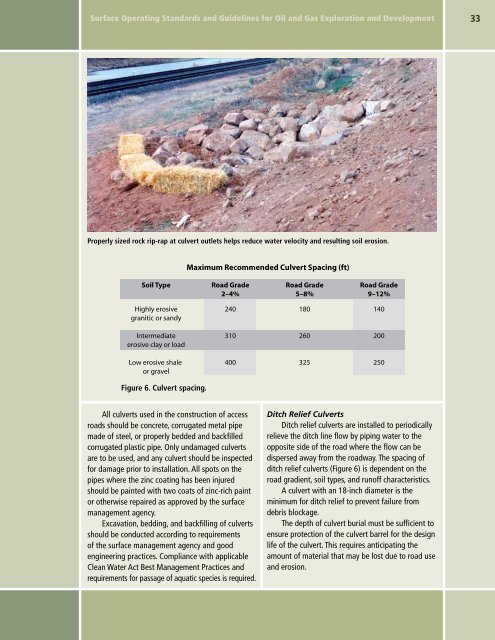Download the Gold Book (pdf 6.3 mb) - Bureau of Land Management
Download the Gold Book (pdf 6.3 mb) - Bureau of Land Management
Download the Gold Book (pdf 6.3 mb) - Bureau of Land Management
You also want an ePaper? Increase the reach of your titles
YUMPU automatically turns print PDFs into web optimized ePapers that Google loves.
Surface Operating Standards and Guidelines for Oil and Gas Exploration and Development<br />
Properly sized rock rip-rap at culvert outlets helps reduce water velocity and resulting soil erosion.<br />
Soil Type Road Grade<br />
2–4%<br />
Highly erosive<br />
granitic or sandy<br />
Intermediate<br />
erosive clay or load<br />
Low erosive shale<br />
or gravel<br />
Figure 6. Culvert spacing.<br />
Maximum Recommended Culvert Spacing (ft)<br />
240<br />
310<br />
400<br />
All culverts used in <strong>the</strong> construction <strong>of</strong> access<br />
roads should be concrete, corrugated metal pipe<br />
made <strong>of</strong> steel, or properly bedded and backfilled<br />
corrugated plastic pipe. Only undamaged culverts<br />
are to be used, and any culvert should be inspected<br />
for damage prior to installation. All spots on <strong>the</strong><br />
pipes where <strong>the</strong> zinc coating has been injured<br />
should be painted with two coats <strong>of</strong> zinc-rich paint<br />
or o<strong>the</strong>rwise repaired as approved by <strong>the</strong> surface<br />
management agency.<br />
Excavation, bedding, and backfilling <strong>of</strong> culverts<br />
should be conducted according to requirements<br />
<strong>of</strong> <strong>the</strong> surface management agency and good<br />
engineering practices. Compliance with applicable<br />
Clean Water Act Best <strong>Management</strong> Practices and<br />
requirements for passage <strong>of</strong> aquatic species is required.<br />
Road Grade<br />
5–8%<br />
180<br />
260<br />
325<br />
Road Grade<br />
9–12%<br />
140<br />
200<br />
250<br />
Ditch Relief Culverts<br />
Ditch relief culverts are installed to periodically<br />
relieve <strong>the</strong> ditch line flow by piping water to <strong>the</strong><br />
opposite side <strong>of</strong> <strong>the</strong> road where <strong>the</strong> flow can be<br />
dispersed away from <strong>the</strong> roadway. The spacing <strong>of</strong><br />
ditch relief culverts (Figure 6) is dependent on <strong>the</strong><br />
road gradient, soil types, and run<strong>of</strong>f characteristics.<br />
A culvert with an 18-inch diameter is <strong>the</strong><br />
minimum for ditch relief to prevent failure from<br />
debris blockage.<br />
The depth <strong>of</strong> culvert burial must be sufficient to<br />
ensure protection <strong>of</strong> <strong>the</strong> culvert barrel for <strong>the</strong> design<br />
life <strong>of</strong> <strong>the</strong> culvert. This requires anticipating <strong>the</strong><br />
amount <strong>of</strong> material that may be lost due to road use<br />
and erosion.

















